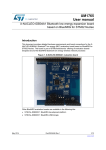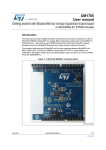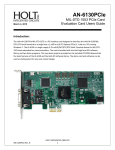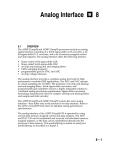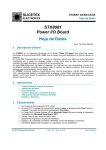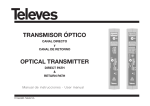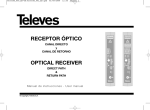Download ADP223/ADP225 User Guide (Rev. C)
Transcript
ADP223/ADP225 User Guide UG-227 One Technology Way • P.O. Box 9106 • Norwood, MA 02062-9106, U.S.A. • Tel: 781.329.4700 • Fax: 781.461.3113 • www.analog.com Evaluating the ADP223/ADP225 Dual, 300 mA Output, Adjustable, Low Noise, High PSRR Voltage Regulator FEATURES GENERAL DESCRIPTION Input voltage range: 2.5 V to 5.5 V Output current range: 0 mA to 300 mA per output Output voltage accuracy: ±1% Operating temperature range: −40°C to +125°C The ADP223/ADP225 evaluation board is used to demonstrate the functionality of the ADP223 and ADP225 dual adjustable linear regulators. The ADP223 and ADP225 are identical except that the ADP225 incorporates the quick output discharge (QOD) function. Simple device measurements, such as line and load regulation, dropout voltage, and ground current consumption, can be demonstrated with only a single voltage supply, voltmeters, a current meter, and load resistors. For more information about the ADP223/ADP225 linear regulator, see the ADP222/ADP223/ADP224/ADP225 data sheet. 09376-001 ADP223/ADP225 EVALUATION BOARD Figure 1. ADP223/ADP225 Evaluation Board (ADP223 Shown for Simplicity) PLEASE SEE THE LAST PAGE FOR AN IMPORTANT WARNING AND LEGAL TERMS AND CONDITIONS. Rev. C | Page 1 of 8 UG-227 ADP223/ADP225 User Guide TABLE OF CONTENTS Features .............................................................................................. 1 Load Regulation ............................................................................5 General Description ......................................................................... 1 Dropout Voltage ............................................................................5 ADP223/ADP225 Evaluation Board .............................................. 1 Ground Current Measurements ......................................................6 Revision History ............................................................................... 2 Ground Current Consumption ...................................................6 Evaluation Board Hardware and Schematic ................................. 3 Printed Circuit Board Layout Considerations...........................7 Evaluation Board Configurations .............................................. 3 Ordering Information .......................................................................8 Output Voltage Measurements ....................................................... 4 Bill of Materials ..............................................................................8 Line Regulation ............................................................................. 4 Related Links ..................................................................................8 REVISION HISTORY 5/14—Rev. B to Rev. C Change to Evaluation Board Configurations Section .................. 3 Changes to Figure 2 .......................................................................... 3 4/12—Rev. A to Rev. B Change to Table 1 ............................................................................. 3 Change to Table 2 ............................................................................. 8 11/11—Rev 0 to Rev. A Added ADP225 ................................................................... Universal 5/11—Revision 0: Initial Version Rev. C | Page 2 of 8 ADP223/ADP225 User Guide UG-227 EVALUATION BOARD HARDWARE AND SCHEMATIC VIN = 4.2V EVALUATION BOARD CONFIGURATIONS The ADP223/ADP225 evaluation board is supplied with different components. Components common to this version are C1, C2, C3, J1, and J2. Figure 2 shows the schematic of the evaluation board configuration. J1 J2 The output voltages can be set according to the following equations: C1 1µF R1 1 ADJ1 8 EN1 R2 ADP223 2 EN2 VOUT1 7 3 GND VIN 6 4 ADJ2 VOUT2 5 VOUT1 = 2.0V C2 1µF R3 VOUT2 = 0.5 V(1 + R3/R4) C3 1µF R4 Figure 2. Evaluation Board Schematic (ADP223 Shown for Simplicity) Table 1. Evaluation Board Hardware Components Component U1 1 C1 C2, C3 J1, J2 R1, R2, R3, R4 1 Function Linear regulator Input capacitor Output capacitors Jumpers Resistors Description ADP223/ADP225 dual adjustable low dropout linear regulator. 1 µF input bypass capacitor, 0402 case. 1 µF output capacitors, 0402 case. Required for stability and transient performance. These jumpers connect EN1 and EN2 to VIN for automatic startup. Select R1 through R4 to set output voltages, 0603 case. Component varies depending on the evaluation board type ordered. Rev. C | Page 3 of 8 09376-002 VOUT2 = 2.8V VOUT1 = 0.5 V(1 + R2/R1) UG-227 ADP223/ADP225 User Guide OUTPUT VOLTAGE MEASUREMENTS LOAD VOLTMETER 1.99711 VOLTAGE SOURCE VOLTMETER 1.99711 09376-003 LOAD Figure 3. Output Voltage Measurement Setup 1. 2. 3. 4. 5. Connect the negative terminal (−) of the voltage source to one of the GND pads on the evaluation board. Connect the positive terminal (+) of the voltage source to the VIN pad of the evaluation board. Connect a load between the VOUT1 pad and GND pad and the VOUT2 pad and GND pad. Connect the negative terminals (−) of the voltmeters to one of the GND pads. Connect the positive terminals (+) of the voltmeters to TB5 (VOUT1) and TB6 (VOUT2). For line regulation measurements, the outputs of the regulator are monitored while the input of the regulator is varied. For good line regulation, the outputs must change as little as possible with varying input levels. To ensure that the device is not in dropout mode during this measurement, VIN must be varied between VOUTNOM + 0.5 V (or 2.5 V, whichever is greater) and VINMAX. For example, for an ADP223/ADP225 with 1.8 V outputs, VIN must be varied between 2.5 V and 5.5 V. This measurement can be repeated under different load conditions. Figure 4 shows the typical line regulation performance of a single 1.8 V output of an ADP223/ADP225. The voltage source can now be turned on. If J1 or J2 is inserted (connecting EN1 or EN2 to VIN for automatic startup), the regulator powers up. 1.820 1.815 1.810 1.805 1.800 1.795 LOAD = 100µA LOAD = 1mA LOAD = 10mA LOAD = 50mA LOAD = 100mA LOAD = 300mA 1.790 1.785 1.780 2.3 2.7 3.1 3.5 3.9 4.3 4.7 5.1 VIN (V) Figure 4. Output Voltage (VOUT) vs. Input Voltage (VIN) Rev. C | Page 4 of 8 5.5 09376-004 Follow these steps to connect to a voltage source and voltmeters: LINE REGULATION VOUT (V) Figure 3 shows the ADP223/ADP225 evaluation board connected to a voltage source and voltmeters for basic output voltage accuracy measurements. Resistors can be used as the load for the regulator. Ensure that the resistors have a power rating adequate to handle the power expected to be dissipated across them. An electronic load can also be used as an alternative. In addition, ensure that the voltage source can supply enough current for the expected load levels. ADP223/ADP225 User Guide UG-227 LOAD REGULATION DROPOUT VOLTAGE For load regulation measurements, the outputs of the regulator are monitored while the loads are varied. For good load regulation, the outputs must change as little as possible with varying load. The input voltage must be held constant during this measurement. The load currents can be varied from 0 mA to 300 mA per output. Figure 5 shows the typical load regulation performance of a single 1.8 V output of the ADP223/ADP225 for an input voltage of 2.5 V over the load current range of 100 µA to 300 mA. Dropout voltage can be measured using the configuration shown in Figure 3. Dropout voltage is defined as the input-to-output voltage differential when the input voltage is set to the nominal output voltage. This applies only for output voltages above 2.5 V. Dropout voltage increases with larger loads. For more accurate measurements, an additional voltmeter can be used to monitor the input voltage across the input capacitor. The input supply voltage may need to be adjusted to account for IR drops, especially if large load currents are used. Figure 6 shows the typical curve of the dropout voltage measurement with different load currents. 1.820 1.815 160 1.810 140 DROPOUT VOLTAGE (mV) 1.800 1.795 1.790 1.785 1 10 LOAD CURRENT (mA) 100 1000 120 100 80 2.8V 3.3V 60 40 20 0 Figure 5. Output Voltage vs. Load Current 1 10 100 LOAD CURRENT (mA) 1000 09376-006 1.780 0.1 09376-005 VOUT (V) 1.805 Figure 6. Dropout Voltage vs. Load Current, VOUT = 2.8 V and VOUT = 3.3 V Rev. C | Page 5 of 8 UG-227 ADP223/ADP225 User Guide GROUND CURRENT MEASUREMENTS LOAD AMMETER VOLTAGE SOURCE 0.00049 09376-007 LOAD Figure 7. Ground Current Measurement Setup 1. 2. 3. 4. Connect the positive terminal (+) of the voltage source to the VIN pad of the evaluation board. Connect the negative terminal (−) of the ammeter to one of the GND pads of the evaluation board. Connect the positive terminal (+) of the ammeter to the negative (−) terminal of the voltage source. Connect a load between the VOUT1 pad and/or the VOUT2 pad of the evaluation board and the negative (−) terminal of the voltage source. Ground current measurements can determine how much current the internal circuits of the regulator are consuming while the circuits perform the regulation function. To be efficient, the regulator must consume as little current as possible. Typically, the regulator uses the maximum current when supplying its largest load level (300 mA per output). Figure 8 shows the typical ground current consumption for various load levels at an input voltage of 2.5 V for the single and dual output configurations. The current shown in Figure 8 does not include the current due to the output voltage setting dividers. 250 SINGLE OUTPUT DUAL OUTPUT 200 The voltage source can now be turned on. If J1 or J2 is inserted (connecting EN1 or EN2 to VIN for automatic startup), the regulator powers up. 150 100 50 0 0.1 1 10 100 LOAD CURRENT (mA) 09376-008 Follow these steps to connect to a voltage source and ammeter: GROUND CURRENT CONSUMPTION GROUND CURRENT (µA) Figure 7 shows how the ADP223/ADP225 evaluation board can be connected to a voltage source and an ammeter for ground current measurements. Resistors can be used as the load for the regulator. Ensure that the resistors have a power rating adequate to handle the power expected to be dissipated across them. An electronic load can be used as an alternative. Ensure that the voltage source can supply enough current for the expected load levels. Figure 8. Ground Current vs. Load Current When the device is disabled (EN1 and EN2 = GND), ground current drops to less than 1 µA. Rev. C | Page 6 of 8 ADP223/ADP225 User Guide UG-227 PRINTED CIRCUIT BOARD LAYOUT CONSIDERATIONS Heat dissipation from the package can be improved by increasing the amount of copper attached to the pins of the ADP223/ADP225. 09376-010 Place the input capacitor as close as possible to the VIN and GND pins. Place the output capacitors as close as possible to the VOUT1, VOUT2, and GND pins. Use 0402 or 0603 size capacitors and resistors to achieve the smallest possible footprint solution on boards where area is limited. 09376-009 Figure 10. Typical Board Layout, Bottom Side Figure 9. Typical Board Layout, Top Side Rev. C | Page 7 of 8 UG-227 ADP223/ADP225 User Guide ORDERING INFORMATION BILL OF MATERIALS Table 2. Qty 1 2 2 1 Reference Designator C1 C2, C3 J1, J2 U1 Description Capacitor, MLCC, 1.0 µF, 10 V, 0402, X5R Capacitor, MLCC, 1 µF, 4 V, 0402, X5R Header, single, STR, 36-position IC, LDO regulator Manufacturer/Vendor Murata or equivalent Murata or equivalent Digi-Key Corp. Analog Devices, Inc. 4 R1, R2, R3, R4 Resistor, 1%, 0603, select values for output voltage Vishay Vendor Part No. GRM155R61A105KE15 GRM155R60G225ME15 S1012E-36-ND ADP223ACPZ-R7, ADP225ACPZ-R7 CRCW0603xxxxF RELATED LINKS Resource ADP223/ADP225 Description Product Page, Dual, 300 mA Output, Adjustable, Low Noise, High PSRR Voltage Regulator ESD Caution ESD (electrostatic discharge) sensitive device. Charged devices and circuit boards can discharge without detection. Although this product features patented or proprietary protection circuitry, damage may occur on devices subjected to high energy ESD. Therefore, proper ESD precautions should be taken to avoid performance degradation or loss of functionality. Legal Terms and Conditions By using the evaluation board discussed herein (together with any tools, components documentation or support materials, the “Evaluation Board”), you are agreeing to be bound by the terms and conditions set forth below (“Agreement”) unless you have purchased the Evaluation Board, in which case the Analog Devices Standard Terms and Conditions of Sale shall govern. Do not use the Evaluation Board until you have read and agreed to the Agreement. Your use of the Evaluation Board shall signify your acceptance of the Agreement. This Agreement is made by and between you (“Customer”) and Analog Devices, Inc. (“ADI”), with its principal place of business at One Technology Way, Norwood, MA 02062, USA. Subject to the terms and conditions of the Agreement, ADI hereby grants to Customer a free, limited, personal, temporary, non-exclusive, non-sublicensable, non-transferable license to use the Evaluation Board FOR EVALUATION PURPOSES ONLY. Customer understands and agrees that the Evaluation Board is provided for the sole and exclusive purpose referenced above, and agrees not to use the Evaluation Board for any other purpose. Furthermore, the license granted is expressly made subject to the following additional limitations: Customer shall not (i) rent, lease, display, sell, transfer, assign, sublicense, or distribute the Evaluation Board; and (ii) permit any Third Party to access the Evaluation Board. As used herein, the term “Third Party” includes any entity other than ADI, Customer, their employees, affiliates and in-house consultants. The Evaluation Board is NOT sold to Customer; all rights not expressly granted herein, including ownership of the Evaluation Board, are reserved by ADI. CONFIDENTIALITY. This Agreement and the Evaluation Board shall all be considered the confidential and proprietary information of ADI. Customer may not disclose or transfer any portion of the Evaluation Board to any other party for any reason. Upon discontinuation of use of the Evaluation Board or termination of this Agreement, Customer agrees to promptly return the Evaluation Board to ADI. ADDITIONAL RESTRICTIONS. Customer may not disassemble, decompile or reverse engineer chips on the Evaluation Board. Customer shall inform ADI of any occurred damages or any modifications or alterations it makes to the Evaluation Board, including but not limited to soldering or any other activity that affects the material content of the Evaluation Board. Modifications to the Evaluation Board must comply with applicable law, including but not limited to the RoHS Directive. TERMINATION. ADI may terminate this Agreement at any time upon giving written notice to Customer. Customer agrees to return to ADI the Evaluation Board at that time. LIMITATION OF LIABILITY. THE EVALUATION BOARD PROVIDED HEREUNDER IS PROVIDED “AS IS” AND ADI MAKES NO WARRANTIES OR REPRESENTATIONS OF ANY KIND WITH RESPECT TO IT. ADI SPECIFICALLY DISCLAIMS ANY REPRESENTATIONS, ENDORSEMENTS, GUARANTEES, OR WARRANTIES, EXPRESS OR IMPLIED, RELATED TO THE EVALUATION BOARD INCLUDING, BUT NOT LIMITED TO, THE IMPLIED WARRANTY OF MERCHANTABILITY, TITLE, FITNESS FOR A PARTICULAR PURPOSE OR NONINFRINGEMENT OF INTELLECTUAL PROPERTY RIGHTS. IN NO EVENT WILL ADI AND ITS LICENSORS BE LIABLE FOR ANY INCIDENTAL, SPECIAL, INDIRECT, OR CONSEQUENTIAL DAMAGES RESULTING FROM CUSTOMER’S POSSESSION OR USE OF THE EVALUATION BOARD, INCLUDING BUT NOT LIMITED TO LOST PROFITS, DELAY COSTS, LABOR COSTS OR LOSS OF GOODWILL. ADI’S TOTAL LIABILITY FROM ANY AND ALL CAUSES SHALL BE LIMITED TO THE AMOUNT OF ONE HUNDRED US DOLLARS ($100.00). EXPORT. Customer agrees that it will not directly or indirectly export the Evaluation Board to another country, and that it will comply with all applicable United States federal laws and regulations relating to exports. GOVERNING LAW. This Agreement shall be governed by and construed in accordance with the substantive laws of the Commonwealth of Massachusetts (excluding conflict of law rules). Any legal action regarding this Agreement will be heard in the state or federal courts having jurisdiction in Suffolk County, Massachusetts, and Customer hereby submits to the personal jurisdiction and venue of such courts. The United Nations Convention on Contracts for the International Sale of Goods shall not apply to this Agreement and is expressly disclaimed. ©2011–2014 Analog Devices, Inc. All rights reserved. Trademarks and registered trademarks are the property of their respective owners. UG09376-0-5/14(C) Rev. C | Page 8 of 8








